Diabetes Mellitus, or as it is commonly known ‘Sugar Diabetes’ is a medical problem affecting not only humans but dogs too. Some pure breeds of dogs are more susceptible to diabetes, but are Cavalier King Charles Spaniels on that list?
Diabetes can affect any breed of dog and is extremely detrimental to a Cavalier’s health if not treated in a timely manner. Diabetes cannot be cured but with expert medical attention, your Cavalier can live a happy life for many more years.
So diabetes can affect Cavalier King Charles Spaniels, but what is diabetes, what is required to treat them, and what are the symptoms? After experiencing all this firsthand with my Cavalier, we have decided to write about everything we learned along the way.
What is Diabetes
When your Cavvy eats their food it is taken down into the stomach and processed for its nutrients. Some of those nutrients are glucose (which is a type of sugar), the glucose travels to the intestines and is then released into the bloodstream, where it is able to travel all around the body.
The glucose and other nutrients travel around the body ready to feed the body’s cells. However, the cells need to be told to grab the nutrients and glucose, and it is insulin that does this.
Insulin is created in an organ called the pancreas (that sits near the stomach) and is vital to tell the cells to use the glucose produced from the food. If there isn’t enough insulin, or the body isn’t using the insulin as it should, then the cells won’t use the glucose.
What Happens if Glucose isn’t used?
This can be a major problem as the body’s cells are starving, and need the fuel-rich glucose, but they are unable to use it. So instead the cells start to break down the body’s fat and muscle protein to feed themselves.
As the glucose is now building up in the bloodstream, it can cause damage to other parts of the body. Eyes, kidneys, nerves, veins, and even the heart can be damaged by excessive amounts of glucose in the body.
Symptoms
When the glucose starts to build up in the bloodstream, your Cavalier’s body will try to get rid of it, and the best way is to flush it out in its urine, and so, to create more urine, your Cavvy’s body will need a lot more water.
As a result, the symptoms to look out for are:
Excessive Thirst – With all that glucose running havoc in your Cavvy’s bloodstream, it will try to get it out as soon as possible, so your poor Cavalier will be drinking a lot more than normal. This was one of the first things we noticed with Lady, our Cavvy, as she would drink bowl after bowl of water.
Increased Urination – This is the body’s plan, more water in, more water out to flush out all the glucose that is not being used. This was the next thing we noticed in Lady, she was drinking 2 large bowls of water through the night, and so she had a few accidents. Her tiny bladder couldn’t hold it all in, poor thing.
Weight Loss – Lady was always a bit chunky, she’s a Cavalier, and all Cavaliers love their food. But we started to notice rapid weight loss, and this was after the diagnosis. The weight seemed to drop off her, in a month she lost 2kg (almost 4 and a half pounds). This was the shocking thing as she was still eating lots.
Increased Appetite – After researching the disease we found out why Lady was losing weight whilst eating lots. As her body was using fat and muscle protein to feed the cells, which made her very hungry and also made her lose weight.
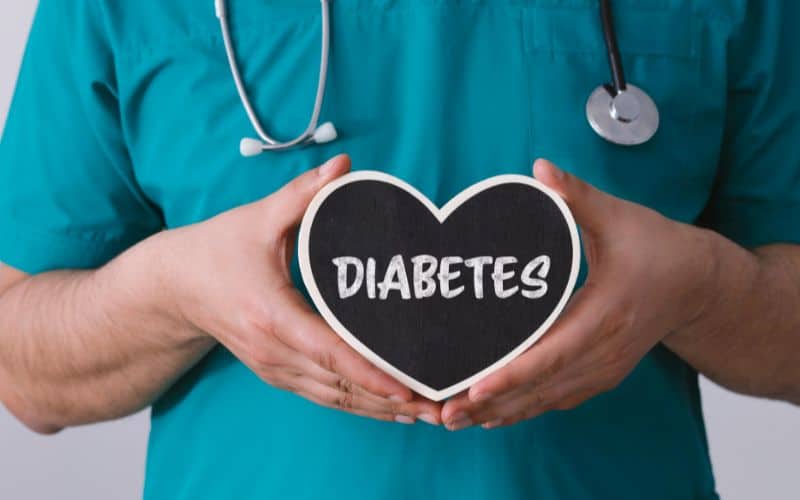
Diagnosis
After the excessive drinking and a couple of accidents around the house, we called our local veterinarian and booked an appointment for Lady to see the vet that day. They asked us to bring a water sample for them to test.
When we got to the vet they performed a dip test on the urine, and they confirmed that there was glucose present, a sure sign of potential diabetes. But to be on the safe side, they sent the urine for lab analysis, and sure enough, it came back as extremely high for glucose.
So the next day we had to take Lady back for a blood sample which also has to go to the lab for analysis. This would give a much better reading and would confirm diabetes.
Unfortunately for us and Lady, it came back as a solid confirmation, and we were requested to go to see the vet to discuss the ongoing treatment required.
Treatment
We arrived at the veterinarian’s surgery the next day, we being myself and my daughter, Livvy, in case I forgot any of the important stuff.
Treatment seems very easy at first, with 2 injections of insulin each day after meals, and for the rest of their lives. Simple, until you realize that there is no set amount of insulin specified, you have to learn what your dog needs, and this is where the stress begins.
Finding the right dosage of insulin required means a blood sugar curve needs to be created, this involves taking samples of blood every 2 hours and testing them in a glucometer. Depending on your dog, this may need to be done over a 12 or 24-hour period and may need to be admitted to the surgery for it.
Lady is a very timid Cavalier and has been all her life. She will very rarely approach a stranger unless you are one of the privileged few, she knows if you are a dog lover and especially if you are a Cavvy owner. So as a result of this, the vet thought it best for us to do it, and so we had to perform the blood sugar curve ourselves.
But before we could even begin to think about the blood sugar curve we had to get her on insulin, straight after her evening meal. So we were told to start on a low dose of 4 units of insulin, after all, some insulin is better than nothing.
We had to keep her on the 4 units for at least a week, at then perform the curve.
Complications
The very same day we started the insulin injections Lady started to act strange. Her left eye was completely closed, and the lower lid of her right eye was sagging.
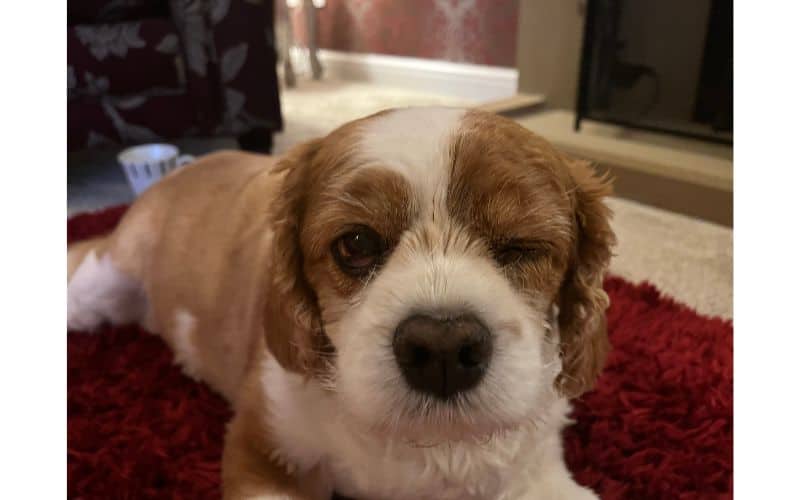
Frantic, we thought she was having some sort of allergic reaction, and so we called the emergency 24 hours vet surgery. They asked us to take a photo and email it to them. After inspection, they thought it would be best for her to come in as an emergency for a check-up. Hey, Lady is insured, so let’s go for it.
Lo and behold, as soon as we got to the veterinarian’s surgery Lady looked absolutely fine, and if it weren’t for the photos being emailed they would have thought we were lying. Anyhow, they gave her a thorough check-up and sent us home.
The Next Evening
Lady was very unsettled and was pacing up and down in the living room, Sarah, my wife, had gone to bed, but I had stayed downstairs to finish the end of the TV show I was watching. She wanted to go outside, so I let her out and she immediately vomited.
The vomiting lasted all night, it was a Friday evening and wasn’t at work the next day, but Sarah was, so I stayed up all night with her. By 7 am we were both shattered, Lady had fallen asleep on her favorite cushion, and I went to bed for a couple of hours.
Saturday Morning
Around 10 am Sarah woke me up (she was concerned about Lady, so didn’t go to work), if I sleep too long in the day I’d be up all night again, a by-product of working shifts for 6 years sometime back.
We were having a coffee and a chat, and Lady wanted to go outside again, so I followed her in case she was going to vomit again. Phew, she only wanted to pee. But after her very long peeing session she stepped forward and stooped down for another go, but this time 2 drops of blood came out.
We immediately called the out-of-hours vet surgery, and they suggested bringing her in again, so we did.
At the Veterinarian Surgery
We took in a urine sample as requested previously on the phone, and they tested it for everything. They confirmed blood in her urine, even though you were unable to see it, and also very high levels of glucose and ketones were present.
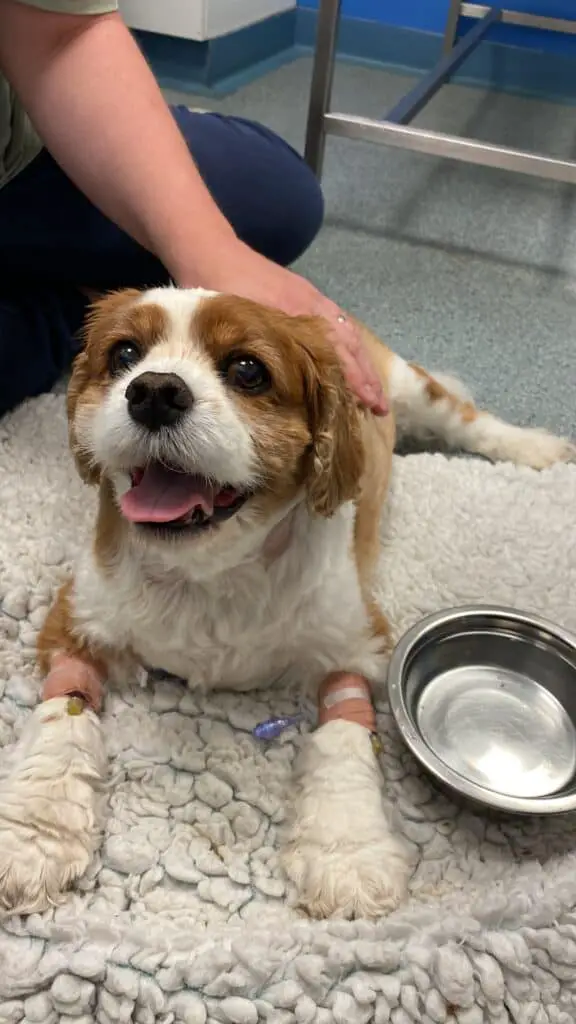
The vet explained to us that Lady was in a very scary situation called ketoacidosis, basically, her body was not using the glucose as fuel, and instead was eating away at her fat and muscle mass, and as a direct result of this, bacteria were feeding off the glucose and cause a UTI (Urinary Tract Infection).
She also explained that we had caught this early, and if we had left it another 24 hours, Lady could have died. My stomach turned over, I couldn’t believe that this had happened in such a short space of time.
The vet then took a blood sample and tested it with a glucometer, and the reading was off the charts. She needed to be admitted immediately and be placed on a drip containing insulin, saline, and paracetamol as she was in pain.
She stayed in the veterinary surgery for 3 days and 2 nights, and as she is so very timid, she wouldn’t eat unless we were there. So we had to travel there each morning and evening to feed her, but that was the least we could do.
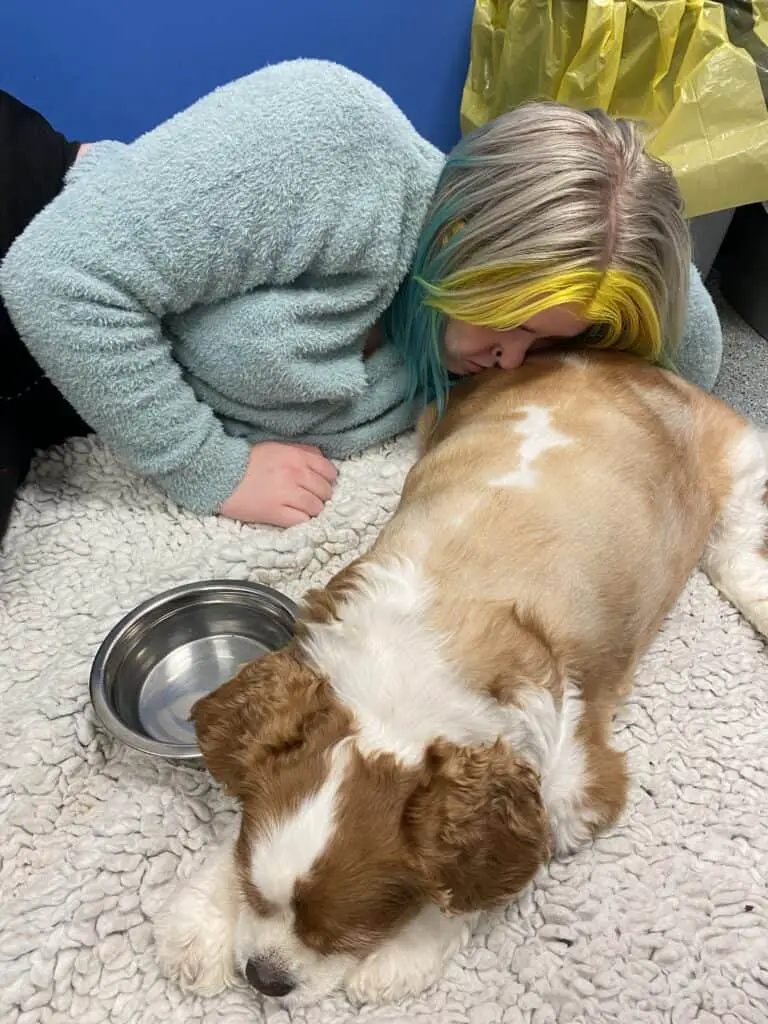
Discharge
Lady was discharged on a Monday evening, and we had strict instructions to see our regular veterinarian for a course of antibiotics, as the UTI was still very much active in her system, but the pain had subsided.
The very next day, Sarah and Lady went to the vet and got a prescription for 10 days’ worth of penicillin for her, none of us are allergic so it was no problem. We were also told to increase her insulin dose from 4 units to 6 and keep her on that dose for a week and then perform a blood sugar curve.
The Blood Sugar Curve
During the week of Lady being on 6 units of insulin, and her antibiotics, she got much better, and so we decided to purchase a glucometer from Amazon for both emergencies and for her blood sugar curve readings. We then booked a day with one of the veterinary nurses to show us exactly how to use it.
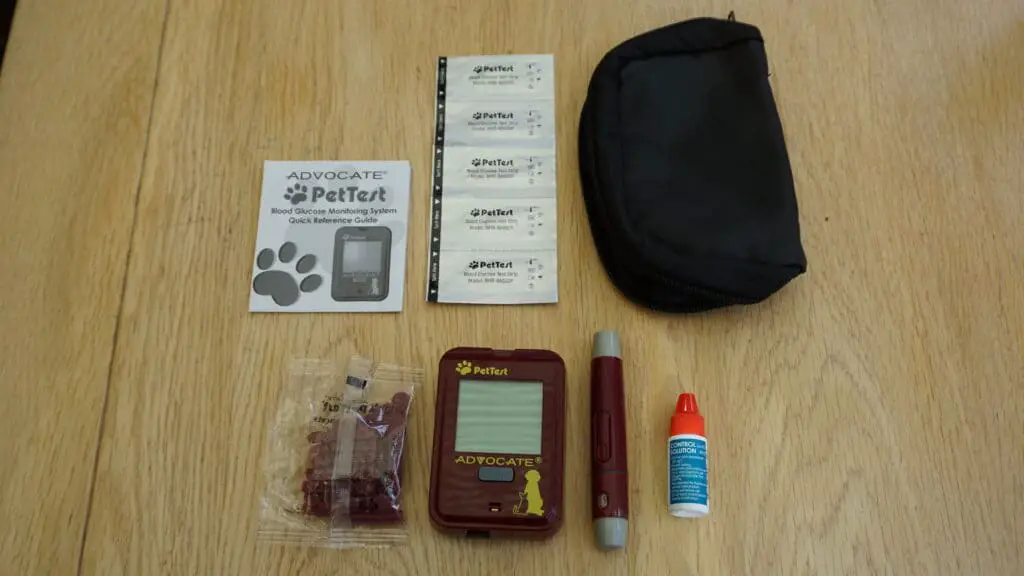
First of all, we had to shave the inside of Lady’s ears, apparently, she is super hairy in the ear department compared to other dogs, I wouldn’t know to be honest, how many people go around looking at the inside of dogs ears to see how hairy they are.
Then we loaded the lancet needle into the “lancing device” or a “lancer”, pulled back on the handle to cock it, and then pressed the button to fire it into Lady’s ear. She was completely fine, didn’t even flinch, and out came a small globule of blood.
If we hadn’t shaved her ear the blood would have soaked into the hair, and we would have had to have done the whole process again. So that was a top tip from the nurse.
We then picked up the glucometer, which we had previously loaded with a blood test strip, and collected a small sample of blood. This is when Lady nearly jumped out of her skin, the machine made a beep when there was sufficient blood collected, right down her ear. As I stated before, Lady is super timid.
The result was 412 mg/dL (or milligrams per decilitre in English), I looked at the nurse to see if this was okay, and she looked confused. “We don’t measure in that, so I’m not sure, we measure in mmol/L (millimoles per liter)”. A swift Google search later and she had a conversion calculator on the screen, 22.9 mmol/L.
So I was all set. All I had to do is start the next day and do a test first thing in the morning, but before her breakfast.
Performing the Curve
Taking the blood samples from Lady was stressful, to say the least. She wasn’t a fan of having needles in her ear every 2 hours, so she hid, moved around whilst we were trying to do it, and even yelped at times.
Sarah and I even argued at one point because we were unable to get enough blood out of Lady’s ear and had to prick her 5 times during that one test, it must have been awful for her, but it had to be done.
Initially, I was writing things down in a book, but that soon became a mass of scrawl, with edits and incorrect calculations. So I decided to make a spreadsheet, as I am a geek at heart and it kept my mind busy in between blood samples, plus it made it easier to print off and simply hand it to our vet.
The spreadsheet data plotted a graph so that I was able to see the actual curve that we were supposed to see, but it wasn’t a curve, more of a rollercoaster ride. She was obviously not on the right amount of insulin.
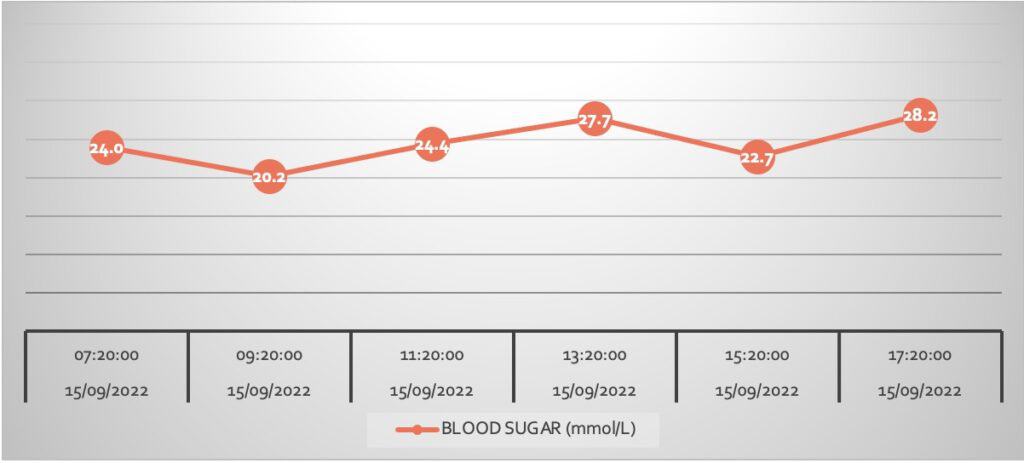
As I am sure there are many people out there in the same situation as us, I have created a downloadable link to my spreadsheet below. It is completely free so download it as many times as you like, and also pass it on to your friends and family.
After the ‘so-called curve’ was handed to my local vet for analysis he called us that evening and requested that Lady was to increase her insulin to 8 units. Then after another week, we are to perform another curve.
So that’s it, we will continue to monitor Lady very closely and be guided by her blood glucose levels, and ketones in her urine. We have since purchased some urine strips from Amazon and monitor for blood, glucose, and ketones every other day, just for peace of mind.
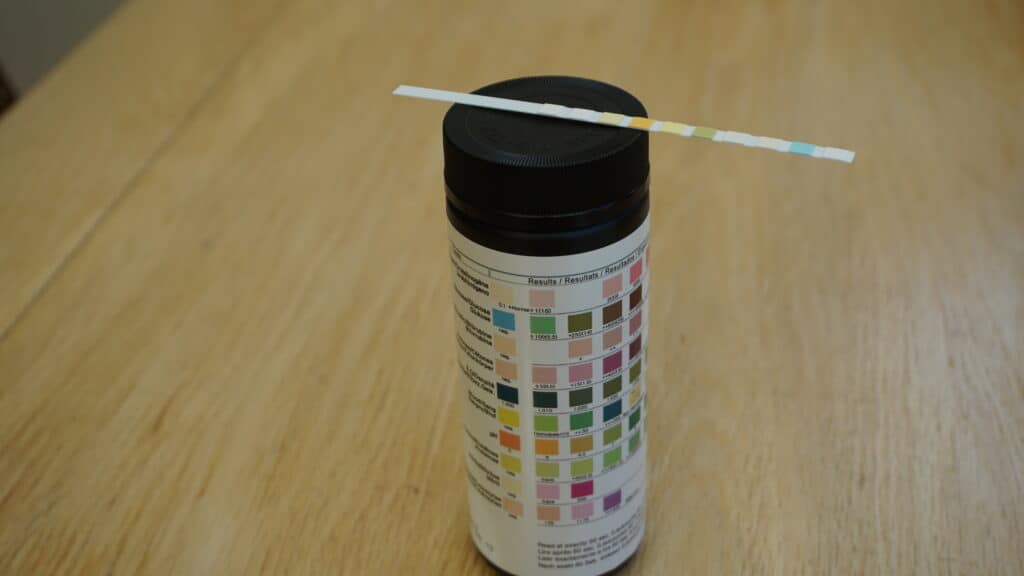
Things to Watch out for
If you are concerned that your dog may have diabetes then these are the tell-tale signs:
- Excessive Thirst
- Excessive Urination
- Rapid Weight Loss
- Increased Appetite
If your dog already has diabetes, then look out for vomiting, and blood in their urine, as UTIs are prevalent in dogs with diabetes.
I strongly urge you to purchase a blood glucose monitor and some urine test strips, as they are relatively inexpensive when compared to the cost of an emergency out-of-hours veterinary inspection, and just help you to relax knowing that your precious pooch is okay.
Sources
For more in-depth knowledge and information on diabetes in dogs, please refer to the sources of my information.
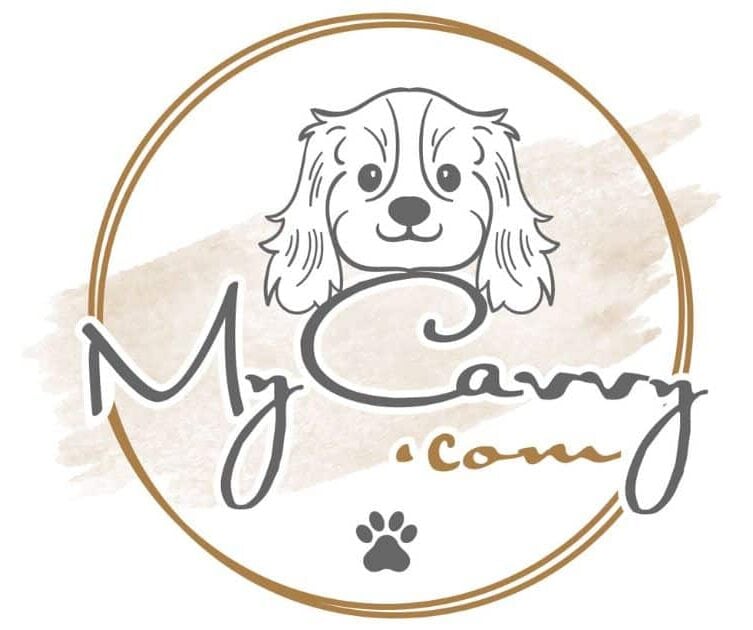

5 thoughts on “Diabetes: Is it a Problem for Cavaliers”